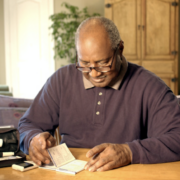Towards a self-reported assessment of physical frailty: updates and challenges
Physical frailty is commonly defined by the Physical Frailty Phenotype (Fried et al, 2001), which uses a combination of self-report and objective measures. Physical frailty is a powerful predictor of health outcomes, but it is rarely used outside of research settings because of challenges with implementation. In a busy clinical setting, performing repeated grip strength and timed walking tests is rarely feasible. Self-report questionnaires, in contrast, are easily administered both in the office and even at home for telemedicine visits. Currently, fully self-reported assessments, such as the FRAIL Scale, are not strongly correlated with the PFP (Aguayo et al, 2017). We therefore set out to develop a self-reported tool that would correlate well with physical frailty, and thus be useful in settings with time and resource constraints.
In our recent study published in the BMC Geriatrics, we tested several possible self-reported frailty phenotypes which included different combinations of questions focused on slowness and weakness (Buta et al, 2022). When we substitute sets of 3 questions for each of the objective measures in the PFP there was substantial agreement between standard and self-reported measures of physical frailty for a 2-level model of frail/non-frail (Kappa=0.76– 0.78). We also found the highest sensitivity (86.4%) and negative predictive value (98.7%) for identifying frail older adults when comparing the standard PFP to a self-reported version that included these 3 slowness- and 3 weakness-related questions. The self-report tool took participants less than 5 minutes to complete.

We found only fair-to-moderate levels of agreement in a 3-level model that categorized participants as either frail, pre-frail or non-frail. Also, the generalizability of our findings may be limited by the study population of aging registry participants from the Baltimore area. Compared to US national demographics (US Census Bureau), our study population had a higher prevalence of participants who were female; African American; and had completed a bachelor’s degree or higher.
 Our results show the utility as well as the challenges of using self-reported questions to identify a frailty phenotype in clinic. Additional testing in general clinic populations should be done, with refinement of the questionnaire as needed, since a self-reported physical frailty measure with high agreement to the standard phenotype will be a valuable frailty screening assessment in both clinical and telehealth settings. To this end, we have recently published complementary work in a larger epidemiological study that highlights the importance of selecting viable self-report measures: common self-reported disability questions do not appear to serve as strong proxies for the physical frailty phenotype’s performance-based measures (Bandeen-Roche et al, 2023). Additional efforts to simplify the assessment of physical frailty are ongoing (Chen et al, 2023).
Our results show the utility as well as the challenges of using self-reported questions to identify a frailty phenotype in clinic. Additional testing in general clinic populations should be done, with refinement of the questionnaire as needed, since a self-reported physical frailty measure with high agreement to the standard phenotype will be a valuable frailty screening assessment in both clinical and telehealth settings. To this end, we have recently published complementary work in a larger epidemiological study that highlights the importance of selecting viable self-report measures: common self-reported disability questions do not appear to serve as strong proxies for the physical frailty phenotype’s performance-based measures (Bandeen-Roche et al, 2023). Additional efforts to simplify the assessment of physical frailty are ongoing (Chen et al, 2023).
The results of this study suggest that a self-report assessment would be valuable as a screening tool if it has low rate of “false negatives”–that is we are unlikely to miss people who would be categorized as frail by the standard phenotype. In order to optimize clinical intervention early in the course of physical frailty, a sensitive screening tool that is easy to administer followed by targeted objective tests to confirm frailty is an efficient strategy but depends on the effectiveness of the interventions. In Europe, a population wide, app-based frailty screening effort is underway that includes interventional targets following screening and comprehensive evaluation (Subra, 2012). It will be important in the future to follow up this research with high quality intervention studies.




